Do Plants Really Can See, Touch, Smell, Hear and Even Taste?

Scientist Daniel Chamovitz unveils the surprising world of plants that see, feel, smell—and remember.
A plant, he argues, can see, smell and feel. It can mount a defense when under siege, and warn its neighbors of trouble on the way. A plant can even be said to have a memory. But does this mean that plants think — or that one can speak of a “neuroscience” of the flower?
Have you ever wondered what the grass under your feet feels, what an apple tree smells, or a marigold sees? Plants stimulate our senses constantly, but most of us never consider them as sensory beings too.
They certainly lack noses, eyes, ears, mouths and skin, but in what follows, but he hopes to convince people that the sensory world of plants is not so very different from our own.
TOUCH

Plants live in a very tactile world. Branches sway in the wind, insects crawl across leaves, and vines search out supports to hang on to. Plants are even sensitive to hot and cold, allowing them to respond to the weather by doing things like changing their growth rates and modulating their use of water. Simply touching or shaking a plant is often enough to reduce its growth, which is why vegetation in windswept locations tends to be stunted.
All plants can sense mechanical forces to some degree, but tactile sensitivity is most obvious in the carnivorous Venus flytrap. When a fly, beetle or even a small frog crawls across its specially adapted leaves, these spring together with surprising force, sandwiching the unsuspecting prey and blocking its escape. The Venus flytrap (pictured) knows when to shut because it feels its prey touching large hairs on the two lobes of the trap. But it won’t just snap shut with any stimulation – at least two hair touches must occur within about 20 seconds of each other. This helps to ensure that the prey is the ideal size and will not be able to wiggle out of the trap once it closes.
HEARING

You have probably heard conflicting stories about the musical preferences of plants. Some people are convinced they flourish when exposed to classical compositions, others believe that heavy metal or bebop does the trick. Strangely, plants’ musical tastes show a remarkable congruence with those of the humans reporting them. Although research in this area has a long history, most of it is not very scientific and, if you think about it, experiments studying music and plants were doomed from the start.
Music is not ecologically relevant for plants, so we shouldn’t expect them to be tuned in to it. But there are sounds that, at least theoretically, it could be advantageous for them to hear. These include the vibrations produced by insects, such as a bee’s buzz or an aphid’s wing beat, and minuscule sounds that might be created by even smaller organisms. Plants might even benefit from the ability to detect certain sounds produced by other plants.
SIGHT

What do plants see? The obvious answer is that, like us, they see light. Just as we have photoreceptors in our eyes, they have their own throughout their stems and leaves. These allow them to differentiate between red and blue, and even see wavelengths that we cannot, in the far red and ultraviolet parts of the spectrum. Plants also see the direction light is coming from, can tell whether it is intense or dim and can judge how long ago the lights were turned off.
Studies have shown that plants bend to the light as if hungry for the sun’s rays, which is exactly what they are. Photosynthesis uses light energy to turn carbon dioxide and water into sugar, so plants need to detect light sources to get food. We now know they do this using phototropins – light receptors in the membranes of cells in the plant’s tip. Phototropins are sensitive to blue light. When they sense it, they initiate a cascade of signals that ends up modulating the activity of the hormone auxin. This causes cells on the shaded side of the stem to elongate, bending the plant towards the light.
SMELL
The parasitic vine called dodder is the sniffer dog of the vegetable world. It contains almost no chlorophyll – the pigment that most plants use to make food – so to eat it must suck the sugary sap from other plants. Dodder uses olfaction to hunt down its quarry. It can distinguish potential victims from their smell, homing in on its favourites and also using scents emitted by unhealthy specimens to avoid them.
Dodder is exceptionally sensitive to odours, but all plants have a sense of smell. In animals, sensors in the nose recognise and bind with molecules in the air. Plants also have receptors that respond to volatile chemicals
TASTE
Our senses of smell and taste are intimately entwined. Conceptually, smells enhance or dampen tastes sensed by our tongues. Physically, our mouths and nasal cavities are connected so that our noses can pick up smells released as food is chewed. The major difference is that smell deals with volatile chemicals and taste senses soluble chemicals.
The two senses are also connected in plants. This is best seen in their responses to attacks by insects or pathogenic bacteria. As we have already seen, plants under attack emit a variety of volatile chemicals to warn their neighbours, but one called methyl jasmonate is particularly important. This is where taste comes in. Although methyl jasmonate is a gas and so an effective airborne messenger molecule, it is not very active in plants. Instead, when it diffuses in through the stomata – the pores in the surface of the leaf – it gets converted into the water-soluble jasmonic acid. This attaches to a specific receptor in the cells and triggers the leaf’s defence responses. Just as our tongues contain receptors for different taste molecules in food, plants contain receptors for different soluble molecules, including jasmonic acid.

Comments are closed.